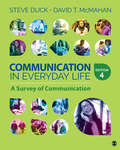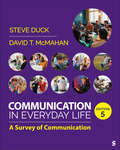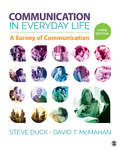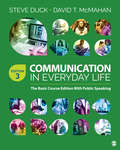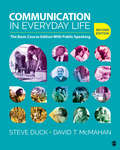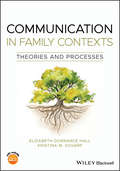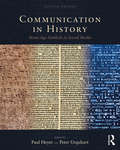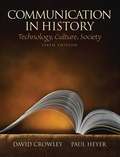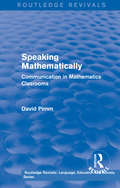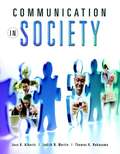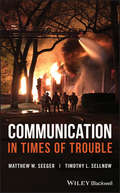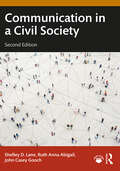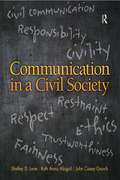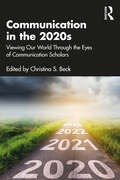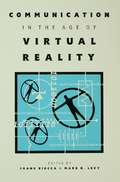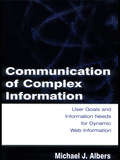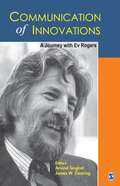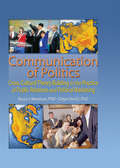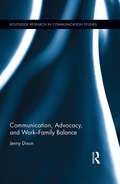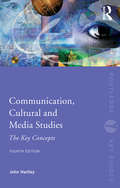- Table View
- List View
Communication in Everyday Life: A Survey of Communication
by Steve Duck David T. McMahanCommunication in Everyday Life: A Survey of Communication offers an engaging introduction to communication based on the belief that communication and relationships are always interconnected. Best-selling authors Steve Duck and David T. McMahan incorporate this theme of a relational perspective and a focus on everyday communication to show the connections between concepts and how they can be understood through a shared perspective. Students will learn how topics in communication come together as part of a greater whole, as well as gain practical communication skills, from listening to critical thinking and using technology to communicate.
Communication in Everyday Life: A Survey of Communication
by Steve Duck David T. McMahanCommunication in Everyday Life: A Survey of Communication offers an engaging introduction to communication based on the belief that communication and relationships are always interconnected. Best-selling authors Steve Duck and David T. McMahan incorporate this theme of a relational perspective and a focus on everyday communication to show the connections between concepts and how they can be understood through a shared perspective. Students will learn how topics in communication come together as part of a greater whole, as well as gain practical communication skills, from listening to critical thinking and using technology to communicate.
Communication in Everyday Life: A Survey of Communication
by Steve Duck David T. McMahanCommunication in Everyday Life explores fundamental concepts, theories, and skills, enabling students to apply the material to their personal and professional lives. With a thematic integration of the relational perspective and a focus on demonstrating its direct relevance to their own everyday communication, authors Steve Duck and David T. McMahan help students build a strong foundation in communication concepts, theory, and research, while developing practical skills such as listening, critical thinking, effective use of technology, understanding nonverbal communication, creating persuasive strategies, and managing group conflicts. With updated coverage of media and technology, new examples, and updated references, the Fifth Edition offers timely insights into modern communication topics central to everyday life.
Communication in Everyday Life: A Survey of Communication
by Steve Duck David T. McMahanCommunication in Everyday Life explores fundamental concepts, theories, and skills, enabling students to apply the material to their personal and professional lives. With a thematic integration of the relational perspective and a focus on demonstrating its direct relevance to their own everyday communication, authors Steve Duck and David T. McMahan help students build a strong foundation in communication concepts, theory, and research, while developing practical skills such as listening, critical thinking, effective use of technology, understanding nonverbal communication, creating persuasive strategies, and managing group conflicts. With updated coverage of media and technology, new examples, and updated references, the Fifth Edition offers timely insights into modern communication topics central to everyday life.
Communication in Everyday Life: A Survey of Communication
by Steve Duck David T. McmahanExplore fundamental communication concepts, theories, and skills aimed at helping students apply communication skills to their personal and professional lives—with a thematic integration of the relational perspective and a focus on demonstrating its direct relevance to their own everyday communication.
Communication in Everyday Life: The Basic Course Edition With Public Speaking
by Steve Duck David T. McMahanCommunication in Everyday Life: The Basic Course Edition With Public Speaking offers an engaging look at the inseparable connection between relationships and communication. Best-selling authors Steve Duck and David T. McMahan expertly combine theory and application to introduce students to communication fundamentals. The book provides a strong foundation in communication concepts, theory, and research, while helping readers master practical communication skills such as listening and critical thinking, using technology to communicate, understanding nonverbal communication, creative persuasive strategies, and managing group conflict.
Communication in Everyday Life: The Basic Course Edition With Public Speaking
by Steve Duck David T. McMahanCommunication in Everyday Life: The Basic Course Edition With Public Speaking offers an engaging look at the inseparable connection between relationships and communication. Best-selling authors Steve Duck and David T. McMahan expertly combine theory and application to introduce students to communication fundamentals. The book provides a strong foundation in communication concepts, theory, and research, while helping readers master practical communication skills such as listening and critical thinking, using technology to communicate, understanding nonverbal communication, creative persuasive strategies, and managing group conflict.
Communication in Everyday Life: The Basic Course Edition With Public Speaking
by Steve Duck David T. McmahanCommunication in Everyday Life: The Basic Course Edition With Public Speaking, Second Edition encourages students to apply basic communication concepts to their daily lives, giving them a deeper understanding of the inseparable connection between relationships and communication. Authors Steve Duck and David T. McMahan expertly combine theory and application to introduce students to fundamental communication concepts and master practical communication skills, such as listening and critical thinking, using technology to communicate, understanding nonverbal communication, creating persuasive strategies, and managing group conflict. The fully updated Second Edition offers practical instruction to improve a student’s ability to effectively communicate interpersonally, in groups, in interviews, and speaking through presentations. Throughout the book, students receive the tools they need to critically analyze their situation, link communication theory to their own experiences, and improve their communication and public speaking skills in the process.
Communication in Family Contexts: Theories and Processes
by Elizabeth Dorrance Hall Kristina M. ScharpAn innovative, student-friendly textbook covering the major elements of the field of Family Communication Family Communication, a rapidly growing sub-discipline within Communication Studies, explores the processes and factors involved in family interactions and relationships. Communication in Family Contexts is a clear and accessible survey of the essential principles, theories, and concepts of the field. Unlike textbooks that present a vast amount of material across only a few chapters—this innovative textbook features brief, easily-understood chapters ideally-suited for undergraduate courses on the subject. The text provides concise yet comprehensive coverage of a diverse range of topics, from fundamental aspects of caretaking and sibling communication, to topics not covered in other textbooks such as estrangement and marginalization. 33 chapters cover theories of family communication, family communication processes, and communicating in family relationships. The authors, noted researchers and educators in the field, complement discussions of standard topics with those of growing contemporary interest, such as LGBTQ family communication, step-family and half-sibling relationships, and the influence of technology on family. This textbook: Provides a well-rounded examination of the major elements of Family Communication studies Explains the foundational theories of the field, including Family Communication Patterns Theory and Relational Dialectics Theory Features numerous practical application exercises to enable students apply theory to practice Includes a complete set pedagogical features, such as case studies, visualizations and models of theories, illustrations, and discussion questions Offers a flexible organizational structure that allows instructors to pick and choose chapters to meet the needs of their courses Communication in Family Contexts: Theories and Processes is an important resource for instructors and students in the field of family communication, the wider discipline of Communication Studies, and related areas such as social psychology and sociology.
Communication in History: Stone-Age Symbols to Social Media (Seventh Edition)
by David Crowley Paul Heyer Peter UrquhartNow in its 7th edition, Communication in History reveals how media has been influential in both maintaining social order and as powerful agents of change. Thirty-eight contributions from a wide range of voices offer instructors the opportunity to customize their courses while challenging students to build upon their own knowledge and skill sets. From stone-age symbols and early writing to the Internet and social media, readers are introduced to an expansive, intellectually enlivening study of the relationship between human history and communication media.
Communication in History: Technology, Culture, Society (Sixth Edition)
by David Crowley Paul HeyerUpdated in a new 6th edition, Communication in History reveals how media has been influential in both maintaining social order and as powerful agents of change. With revised new readings, this anthology continues to be, as one reviewer wrote, "the only book in the sea of History of Mass Communication books that introduces readers to a more expansive, intellectually enlivening study of the relationship between human history and communication history". From print to the Internet, this book encompasses a wide-range of topics, that introduces readers to a more expansive, intellectually enlivening study of the relationship between human history and communication history.
Communication in Mathematics Clasrooms (Routledge Revivals: Language, Education and Society Series #4)
by David PimmFirst published in 1987, this book examines mathematics school teaching from the perspective that it is a language — arguing that this can illuminate many events that occur in classes and highlight issues that may not have previously seemed important. The central concern is with the processes of communication as they are shaped by school conventions and the fact that it is mathematics being discussed. Speaking, listening, writing and reading are examined and analysed with the first half focusing on verbal interactions and the second half examining aspects of pupil written mathematics. Also explored is the nature of the mathematical writing system itself and how pupils gain access to it.
Communication in Society
by Judith N. Martin Thomas K. Nakayama Jess K. AlbertsCommunication in Society explores communication in a larger, social context. Alberts, Martin and Nakayama developed a skills-based framework, to give the reader what they need to communicate effectively as individuals and as members of society. This book helps students learn to clearly understand and take responsibility for the complexities of their individual communication choices.
Communication in Times of Trouble
by Matthew W. Seeger Timothy L. SellnowPresents the best practices of crisis communication and emergency risk communication This book covers crisis communication strategies and focuses on practical applications for effective management. It includes an extensive discussion of best practices in pre-crisis, crisis and post crisis stages. The book pays special attention to the needs of meeting the needs of diverse audiences and communicating in a responsive and responsible way. The principles are appropriate for many kinds of events including earthquakes, tornadoes, hurricanes, tsunamis, epidemics, and pandemics as well as industrial accidents, toxic spills, transportation disasters, fires and intentional events. In the first chapter, Communication in Times of Trouble introduces the concept of best practices and establishes their relevance for crisis communication and emergency risk communication. A chapter is dedicated to each of the ten best practices. In each chapter, the best practice is described, examples of successful and unsuccessful application of the best practice in both organizational crises and natural disasters/emergencies are provided, advice for practical application is given, and a summary is provided. The concluding chapter details the challenges and opportunities for developing and implementing a response strategy that includes the best practices as a whole. Focuses on application and explanation in crisis communication to benefit those with backgrounds in emergency management, risk management, political science, disaster sociology, and public health Covers natural, large-scale emergencies such as earthquakes, tornadoes, hurricanes, tsunamis, epidemics, and pandemics, which aren’t generally detailed in existing crisis communication texts Presents 10 best practices for dealing with emergencies: Process Approach; Pre-Event Planning; Partnerships; Public Concern; Honesty; Collaborate; Media access; Compassion; Uncertainty; Empowerment Communication in Times of Trouble will be of great interest to undergraduate students and practitioners in communication, public relations, public affairs, public information, public health, and emergency management.
Communication in a Civil Society
by Ruth Anna Abigail Shelley D. Lane John Casey GoochUsing the concept of “civility” as the major theme, this fully updated second edition offers a unique and alternative way to teach and learn about communication.The book brings together discrete areas that explore the fundamentals of communication and intrapersonal communication, interpersonal communication, small group communication, and public speaking. Every chapter includes theories, concepts, and examples that allow students to use civil and ethical communication skills in their personal relationships, in collaboration with colleagues, and in giving public speeches and professional presentations. This new edition highlights advances in and concepts related to mediated and technology-based communication, such as chatbots, technostress, and dating apps, and shows how students can engage in civil face-to-face and mediated interaction. Additionally, each chapter includes a real-world incident that students are asked to analyze in terms of specific chapter information and skills related to civility.Communication in a Civil Society is an ideal textbook for Introduction to Communication, Interpersonal Communication, and Public Speaking courses.Materials for instructors including PowerPoint slides, a test bank, and an instructor’s manual, are available at www.routledge.com/9781032513263.
Communication in a Civil Society
by John Gooch Ruth Anne Abigail Shelley D. LaneFirst Published in 2016. Routledge is an imprint of Taylor & Francis, an Informa company.
Communication in the 2020s: Viewing Our World Through the Eyes of Communication Scholars
by Christina S. BeckThis book provides an inside look at the discipline of Communication. In this collection of chapters, top scholars from a wide range of subfields discuss how they have experienced and how they study the crucial issues of our time. The 2020s opened with a series of events with massive implications for the ways we communicate, from the COVID-19 pandemic, a summer of protests for social justice, and climate change-related natural disasters, to one of the most contentious presidential elections in modern U.S. history. The chapters in this book provide snapshots of many of these issues as seen through the eyes of specialists in the major subfields of Communication, including interpersonal, organizational, strategic, environmental, religious, social justice, risk, sport, health, family, instructional, and political communication. Written in an informal style that blends personal narrative with accessible explanation of basic concepts, the book is ideal for introducing students to the range and practical applications of Communication discipline. This book comprises a valuable companion text for Introduction to Communication courses as well as a primary resource for Capstone and Introduction to Graduate Studies courses. Further, this collection provides meaningful insights for Communication scholars as we look ahead to the remainder of the 2020s and beyond.
Communication in the 2020s: Viewing Our World Through the Eyes of Communication Scholars
by Christina S. BeckThis book provides an inside look at the discipline of Communication. In this collection of chapters, top scholars from a wide range of subfields discuss how they have experienced and how they study the crucial issues of our time. The 2020s opened with a series of events with massive implications for the ways we communicate, from the COVID-19 pandemic, a summer of protests for social justice, and climate change-related natural disasters, to one of the most contentious presidential elections in modern U.S. history. The chapters in this book provide snapshots of many of these issues as seen through the eyes of specialists in the major subfields of Communication, including interpersonal, organizational, strategic, environmental, religious, social justice, risk, sport, health, family, instructional, and political communication. Written in an informal style that blends personal narrative with accessible explanation of basic concepts, the book is ideal for introducing students to the range and practical applications of Communication discipline. This book comprises a valuable companion text for Introduction to Communication courses as well as a primary resource for Capstone and Introduction to Graduate Studies courses. Further, this collection provides meaningful insights for Communication scholars as we look ahead to the remainder of the 2020s and beyond.
Communication in the Age of Virtual Reality (Routledge Communication Series)
by Frank Biocca Mark R. LevyThis volume addresses virtual reality (VR) -- a tantalizing communication medium whose essence challenges our most deeply held notions of what communication is or can be. The editors have gathered an expert team of engineers, social scientists, and cultural theorists for the first extensive treatment of human communication in this exciting medium. The first part introduces the reader to VR's state-of-the-art as well as future trends. In the next section, leading research scientists discuss how knowledge of communication can be used to build more effective and exciting communication applications of virtual reality. Looking ahead, the authors explore pioneering approaches to VR narratives, interpersonal communication, the use of 3D sound, and the building of VR entertainment complexes. In the final section, the authors zoom out to view the big picture -- the psychological, social, and cultural implications of virtual reality. Thought-provoking discussions consider important communication issues such as: * How will virtual reality influence perception of reality? * What are the legal issues defining communication in virtual reality? * What kind of cultural trends will this technology encourage?
Communication of Complex Information: User Goals and Information Needs for Dynamic Web Information
by Michael J. AlbersThe amount of information available for any realistic complex situation is likely to overwhelm most users, as well as stymie any designer tasked with presenting the information. Providing large amounts of information in a coherent and usable format remains an unresolved problem. Choosing, structuring, formatting, and displaying information to allow easy access and to facilitate understanding are critical issues for effective design. To build an effective design that addresses complex information needs, one must look at research from psychology, sociology, human computer interaction, and technical communication, and develop a complete picture of the situation. This book develops a foundation for analysis and design of the approaches to providing complex information in real-world situations. Author Michael Albers takes the view that the content of the information system is the most important component. As such, this volume presents the analysis that needs to be done before the interface is designed and before content is created. It strives to provide clear understanding of how the user thinks and what the user needs, so interface operation, content, and presentation can maximize their respective potentials in communicating with a user. This volume is intended for technical communicators, human-computer interaction designers, and information designers. It will also be useful for system designers and researchers, and those studying adaptive hypertext and related topics.
Communication of Innovations: A Journey With Ev Rogers
by Arvind Singhal and James W. DearingThis collection of 10 original essays honors the intellectual legacy of Prof Everett M Rogers (1931-2004), a pioneering and distinguished teacher— scholar of diffusion of innovations, communication networks, and social change. Well-known colleagues and contemporaries write on topics that not only piqued Rogers’ curiosity, but to which he made seminal and lasting contributions. The concluding chapter documents Rogers’ life journey from his modest farm boy beginnings in Iowa, through his distinguished academic career, to his final return to the farm.
Communication of Politics: 8th Inte
by Bruce I NewmanLearn how political marketing and public relations affect the electoral process! Communication of Politics: Cross-Cultural Theory Building in the Practice of Public Relations and Political Marketing examines how communication and marketing experts influence politics. The book reviews the state of the art in political communication management and marketing through a cross-cultural integration of research and theoretical approaches. An international panel of authors presents a comparative assessment of the impact of candidate and party appeals on the electorate, examines case studies from elections in the United States and Europe, and offers innovative models of voter behavior in the United States, Poland, and Slovenia. Communication of Politics provides valuable insights into the merger of political marketing and public relations. The book examines the cause and effect of the increasing role of communications professionals in the political process and documents the relationship between politicians and communications professionals working in electoral committees, political parties, governments, government agencies, consultancies, and polling agencies. Topics addressed by the international panel of scholars and practitioners include: a critical assessment of strategies used in the 2000 United States Presidential election branding as a means of establishing party values and winning support the expanding roles of polls, focus groups and Internet-based research on elections the relationship between foreign affairs/diplomacy and media/public relations Quangos (Quasi-Autonomous Non-Governmental Organizations) and much more! Communication of Politics: Cross-Cultural Theory Building in the Practice of Public Relations and Political Marketing examines the innovative-and sometimes controversial-uses of contemporary electoral marketing. The book is an essential resource for academics, journalists, and political practitioners, including campaign managers, charity fundraisers, public service managers, party-policy-makers-even candidates.
Communication, Advocacy, and Work/Family Balance (Routledge Research in Communication Studies)
by Jenny DixonThis book presents an understanding of work-family balance for working adults belonging to a number of different family structures (e.g. single and/or childfree adults, LGBT couples, families with female breadwinners). It contends that family structure should serve as a way of thinking about diversity (i.e., race, gender, age, family) in the U.S. workplace. It also argues that—in addition to accommodations occurring through workplace policy—the negotiation of work-family balance happens as a result of self-advocacy that occurs in everyday communication about family at work. Relaying the stories of a number of different working adults belonging to a variety of different family structures, it explores the range of obstacles faced in the attempt at balancing work and family life, generates informed ideas for eliminating barriers commonly experienced in balancing work and family, and problematizes enduring assumptions regarding gender roles and the myth of steadfast public and private spheres.
Communication, Cultural and Media Studies: The Key Concepts (Routledge Key Guides)
by John HartleyThis fourth edition of Communication, Cultural and Media Studies: The Key Concepts is an indispensible guide to the most important terms in the field. It offers clear explanations of the key concepts, exploring their origins, what they're used for and why they provoke discussion. The author provides a multi-disciplinary explanation and assessment of the key concepts, from 'authorship' to 'censorship'; 'creative industries' to 'network theory'; 'complexity' to 'visual culture'. The new edition of this classic text includes: Over 200 entries including 50 new entries All entries revised, rewritten and updated Coverage of recent developments in the field Insight into interactive media and the knowledge-based economy A fully updated bibliography with 400 items and suggestions for further reading throughout the text
Communication, Cultural and Media Studies: The Key Concepts (Routledge Key Guides)
by John HartleyNow in its fifth edition, this pioneering volume of Routledge’s ‘Key Concepts’ series offers clear explanations of key concepts, showing where they came from, what they are used for, and why they provoke discussion or disagreement. The new edition is extensively revised to keep pace with rapidly evolving developments in communication, culture and media, providing topical and authoritative guidance to transformational shifts from broadcast to digital technologies, national to global media and disciplinary to diverse knowledge. It includes: Nearly 250 entries, covering what and how to study across this multi-disciplinary field 50 new entries: from algorithm and assemblage, dance and data, to woke and worldbuilding Updated references with 500 items and suggestions for further reading Revisions, updates and examples throughout. For students and seasoned scholars alike, Communication, Cultural and Media Studies is an invaluable resource in an ever-changing landscape.
